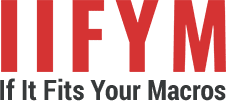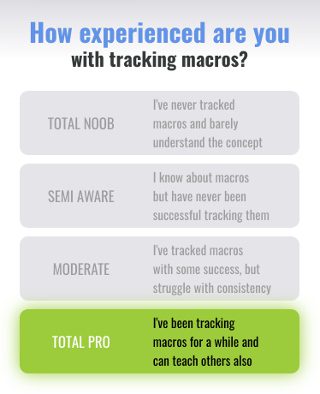Walk into a grocery store and look at any packaged food. Undoubtedly one of the first things you’ll see is the calories per serving listed somewhere on the front of the package. Open the menu at many restaurants and you’ll see a calorie count by the items in the “lighter side” section.
If calories are so beneficial to track, then you may be wondering why physique coaches like me, and resources like the IIFYM flexible dieting calculator list macro goals and not just total calories for an ideal flexible dieting approach?
If you’re already tracking calories, what’s the point of making dieting seemingly more complicated? Well, I’m glad you asked. It’s a great question and a topic that can help you maximize your flexible dieting results much more effectively over the long term, and this article will explain just why that is!
Macros Matter When Flexible Dieting
First and foremost, arguably the biggest benefit to flexible dieting with macros (protein, carbohydrate, and fat) rather than just total calories, is that each macronutrient provides unique benefits to humans.
Not to mention contains unique combinations of nearly countless micro nutrients including vitamins, minerals, antioxidants, phytonutrients and other health-promoting, energy supporting nutrients.
Although total energy balance is a great and major first step, by only tracking calories you may not be achieving adequate intake of these various nutrients. Hit your total calorie goal for the day and an overwhelming portion of your intake comes from carbs, and you’re likely missing out on health-promoting dietary fats.
Pay more attention to fat intake while enjoying carbs, but neglect sufficient protein intake and you’re surely limiting the muscle recovery and growth you can see from your weight training and general exercise routine.
Sure, the common statement of “total energy balance being most important” may hold some truth. However, if you truly want to get the most out of your efforts, flexible dieting with macronutrient goals rather than total calories will head and shoulders bring you more progress.
Macronutrients to Calories Calculator
Protein 1 Gram = 4 Calories
Carbs 1 Gram = 4 Calories
Fat 1 Gram = 9 Calories
*As a brief side note, alcohol itself contains 7 calories per gram, making it an important consideration for total energy balance, especially in a dieting phase.
Thermic Effect of Food
Another reason why flexible dieting via tracking macros can provide more results is that not all macros are created equal when it comes to the energy they provide to us, as well as the energy it requires to metabolize them.
Thermic Effect of Food (TEF), the energy required to metabolism each macronutrient, differs quite substantially between the three macronutrients. In turn, this results in a different, net effect of each on overall body composition.
Degree of TEF
Protein > Carbs > Fat
After seeing this, you may be asking yourself why you should even bother with fat intake, and carbs might even be on the chopping block if you’re looking to drop body fat. The reason kicking carbs & fat out of the kitchen isn’t a good idea is because, again, each will have a unique and important contribution to overall health and performance.
TEF consideration isn’t to target what to cut out, but to simply keep in mind that the overall breakdown of your intake among the three major macros will certainly have an effect on your body composition as you begin a flexible dieting approach.
If we take the total calorie route, for instance, weeks may pass where fat intake is the major contribution to total calories. Along with limiting the benefits achieved through sufficient carb and protein intake, the ability to maximize body composition is limited since fat has the lowest TEF.
On the other hand, the fellow flexible dieting athlete that’s structuring their total calorie intake properly among the three macros will undoubtedly achieve a better overall body composition. This made possible by taking advantage of a consistent balance of TEF, not to mention the much more consistent training performance it will allow.
To achieve such consistency in your diet and fitness, have us build your flexible dieting program.
I’m Not a Bodybuilder, What About Just Calories and Protein?
Although I work with mostly competitive physique athletes, the serious, non-competitive athletes I work with aren’t cutting any corners when it comes to tracking intake just because they aren’t stepping on stage. Something I know the IIFYM coaches practice as well with their clients.
Whether a bodybuilder or someone just focused on looking better from day to day- tracking protein and total calories can be helpful, but it simply leaves too much on the table when it comes to maximizing flexible dieting results.
Each source of calories contains a unique contribution to the human body’s processes and overall health.
The previously mentioned considerations aside, one major reason I still have my non-competitive athletes track macros through flexible dieting is that it provides much more consistent energy from day to day. Not to mention, more predictable performance in the gym.
By taking that extra, and honestly relatively easy, the step of tracking carbs and fat along with protein, we create an environment where the most important variables are controlled each day. Allowing for non-competitors to still take advantage of maximized and predictable energy levels that they can use to enhance their daily activities and overall well-being.
I would also go as far as to say that flexible dieting through tracking all three macros, rather than protein & total calories is actually easier. Sure you have to track more each day. However, it’s much easier to structure beneficial, balanced meals when considering your “budget” for each macro, rather than hitting protein then simply throwing random foods together to meet remaining calories.
Know Your (Macro’s) Role
As I touched on earlier, it’s important to keep in mind that all calories aren’t equal. Each source of calories contains a unique contribution to the human body’s processes and overall health. To only track calories doesn’t lend credit where it’s due in terms of foods’ effect on our bodies.
If you’re flexible dieting in any capacity- it’s likely to be healthier and maximize the quality of life, perform better in a given sport, look better, or some combination. That being the case, sufficient intake and manipulation of all three macronutrients through flexible dieting will have a much-improved effect on all three areas than calories alone.
The exact amount of each that you consume can vary quite a lot from person-to-person. Even researchers in the field of nutrition science have differing opinions on what is most “optimal” for the average person.
Especially as various stages of muscle growth or fat loss phase, the ratios of all three can differ quite a bit from month to month. Regardless of the exact amounts though, it’s impossible to argue that every flexible dieting approach needs at least some of each macronutrient to be its healthiest.
Protein
We all know about protein. Flexible dieting or strict meal plans- a physique-focused individual doesn’t dare skip protein due to its role in muscle recovery and growth. Not only does protein help recover and build muscle, but it’s also known to be very satiating. This is one of many reasons a higher protein intake can be so beneficial for weight management. Since it can help reduce hunger and especially make dieting phases more manageable. (1)
In terms of health, sufficient protein intake can also make it easier to achieve sufficient intake of various micronutrients. Occasional red meat can provide a highly bioavailable form of iron, dairy products like yogurt containing beneficial probiotics, and multiple complete protein sources including poultry, eggs, and meat are high in vitamin b12 which has an important role in DNA production and red blood cell integrity.
Of course, those who avoid certain animal products due to moral obligations can find other sources for many of these. However, in general, consuming consistent protein in a variety of forms can help us better cover many health bases.
A leaner physique and bigger muscles/better shape sound fantastic, so it’s a no a brainer to at least make sure protein intake is sufficient. However, just as important as the blocks used to build the house are the fuel sources that make the building more efficient, and the supporting structures that comprise. That’s where carb and fat intake come into play in a thorough flexible dieting approach.
Carbohydrate

Protein and its importance are rarely argued (although the optimal amount is argued often). However, the importance of carbohydrate in the diet is up there with religion and politics when it comes to incessantly debated beliefs.
Now we have other articles like my Stop Villainizing Sugar for Wide Spread Weight Gain article to discuss what science says about carbohydrate intake, type, and timing to best promote body composition and performance improvements.
So I won’t belabor those points here too. However, we can all agree, at least to some extent, that some carbohydrate in our diet will be absolutely vital for proper health. Regardless of what side of the carb conversation you’re on.
Setting aside the obvious benefits of carbohydrate such as readily used energy sources and cognitive function (plus they taste amazing), non-starchy carbs alone make it clear that tracking carbohydrate intake can have benefit to our health.
Flexible Dieting Leads To More Micronutrients
You’ve heard it since you were a child. If you want to grow up to be big and strong, you need your fruits and vegetables. Once again, mama was right. One article can’t even begin to explain the nearly countless micronutrients that fruits and vegetables contain that is vital for long-term health down to even how good we feel on a day-to-day basis.
Tracking calories only doesn’t provide us with enough data to assess our progress and fine-tune adjustments to really maximize the benefits of our diet.
Flexible dieting with tracking macros rather than calories alone can make it very simple to keep tabs and stay accountable for the servings of fruits, vegetables and whole grains we consume each day for disease prevention, weight management and just feeling our best on a daily basis.
Dietary Fat
We can go ahead and place dietary fat right alongside carbs in that “hot debate” list. A topic for another day, whether you believe flexible dieting should be based on low or high fat composition- we can all agree dietary fats have some darn important roles.
Not only do most fat sources simply make meals taste better, but they’re chalked full of health benefits that often get overshadowed by their caloric density and lower TEF.
Sure, fat can be easier to over-consume and is important to keep in check. However fat’s also an incredible way to add health-promoting nutrients while flexible dieting. In particular through focusing on polyunsaturated fats (while also including some saturated and mono-unsaturated fats) in a diet.
We can improve everything from cognitive function (2), heart health (3) and even long-term body composition & muscle growth through our dietary fat intake (4, 5).
The Importance of All Three

Once again, through tracking specific macronutrients goals, you can make sure you’re getting enough fat to achieve optimal health and performance while keeping tabs on total intake in order to allow for protein and carbohydrate to still have their place in your diet.
The moral of the macros being, all three are important, and this article doesn’t even begin to fully explain just how much these three contribute with their various micronutrients and energy composition.
Flexible dieting, at its best, takes this into account by helping us make sure we’re taking advantage of all three. Tracking calories only doesn’t provide us with enough data to assess our progress and fine-tune adjustments to really maximize the benefits of our diet.
Calorie Needs are Individual
Flexible dieting through macro tracking is better than only tracking calories. Even better? Tracking calories tailored to your needs, not calories suggested to you by nutrition labels or the fad diets thrown out like candy at a parade by nearly every Insta-famous fitspo with a booty.
In reality, for flexible dieting to truly work, each person needs to understand and find his or her specific, current calorie intake.
Jumping to an arbitrary calorie intake can lead to sudden weight gain when far greater than your needs, or negative muscular and metabolic adaptions if fat is lower. Instead, it’s important to find your current average, and then adjust from week to week moving forward.
Working off a random calorie intake for changing body composition is aimless, our coaches can build a diet plan geared towards your needs.
Any client that we work with, we first suggest they use a smartphone application such as MyMacros+ or MyFitnessPal to easily track their food intake. Over the next 2-3 days, they can then track their normal, current diet in order to get an approximate idea of their current calorie intake and macro breakdown.
From there, we can then take the average, use that as our baseline, properly re-distribute macros, then begin adjusting intake each week moving forward to best meet their particular needs and goals.
Generic Calorie Suggestions ≠ Sustainable Progress
This means that those 1,500 calorie and 2,000 calorie intake suggestions you see on nutrition labels and fad magazines are a small step above generic, cookie cutter meal plans. They may provide some initial change, but not long-term progression.
Each person just beginning to use flexible dieting will have very different baseline intakes. Not only that, but your needs will change as your dieting and growth phases progress. Why do they change? I’m glad you asked!
Metabolic Adaption

Coined under a few different phrases, but probably most clearly stated as metabolic adaption- our metabolisms adapt as we continue through a dieting phase. When dieting, we, of course, create a caloric deficit through reduced food intake and/or increased energy output through exercise.
Now our bodies are quite adaptive. Although a simplistic explanation, our bodies are designed to adapt and survive, not with the intent of being as ripped and jacked as possible. So when we begin dieting to drop body fat, our bodies are working to become as efficient as possible along the way. Muscle tissue and metabolic rate progressively become harder to maintain.
When calories, and thus body fat, decline- so too does the total amount of calories our bodies expend from day to day. Resting metabolic rate (RMR) declines as our bodies become more efficient at everyday processes. Casual activity throughout the day tends to decline, hunger hormones increase and other adaptions all occur and comprise a lower and lower energy output along the way. (6,7)
What this shows to the flexible dieting athlete is, the caloric deficit you create during the first few weeks of dieting won’t continue creating the same fat loss. Adjustments to macronutrient intake and energy output will be necessary to accommodate for these adaptions and continue with the consistent fat loss.
So for instance, if you started by consuming 2,500 calories (with an ideal macro distribution) then suddenly dropped to say, 1,500 calories, you may lose significant body fat, to begin with.
However, weight loss will stall once metabolic adaptions occur. Instead, by making gradual adjustments, we can better mitigate that adaption and keep fat loss to a more consistent, manageable, and greater long-term pace.
Growth Phase Adaptions
Similar but alternative adaptions occur as calories are raised during a growth phase. Our metabolisms need time to adapt to increased intakes and/or lower energy outputs. So suddenly spiking food intake will almost certainly lead to greater body fat storage.
On the contrary, incremental adjustments can allow time for positive metabolic adaptions, reduce unnecessary fat storage, and get the metabolism to a more productive spot to fuel training performance and allow more enjoyable food intakes.
Make The Tracked Calories Count
If you’ve already been flexible dieting through calorie tracking, you’re heading in a great direction. However, physique coaches such as myself and the IIFYM macro coaches don’t just want to see you heading in the right direction. We want to make sure your journey is as efficient and enjoyable as possible along the way.
Taking the extra step with your flexible dieting by tracking macro goals can make sure you’re getting the absolute most out of your efforts, and make all those calories you track truly count.


